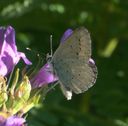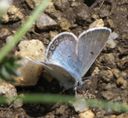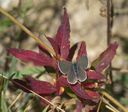Plebejus
Plebejus
Classification
- Phylum: Arthropoda
- Subphylum: Hexapoda
- Class: Insecta
- Order: Lepidoptera
- Superfamily: Papilionoidea
- Family: Lycaenidae
- Subfamily: Polyommatinae
- Genus: Plebejus
Pronunciation
How to pronounce Plebejus: //pleˈbe.jus//
These audio files are automatically generated. While they are not always 100% accurate, they are a good starting point.
Images






Summary
Plebejus is a diverse genus of butterflies within the family Lycaenidae, recognized for its extensive species list and complex taxonomy influenced by molecular studies. Many species are characterized by their distinctive wing patterns and variable habitats, spanning across continents.
Physical Characteristics
Species of Plebejus often exhibit dark markings that may be ringed in white, with variations in the arrangement and shape of spots depending on the species. They generally have wings with different shapes, with characteristics such as a straight outer margin or pointed wing tips.
Identification Tips
Identify Plebejus butterflies by examining the underwing pattern closely, which may show distinct spots and markings. Look for the degree of orange pigment on the wings and observe the habitat where the butterfly is found. Helpful features include the number of spots in the discal cell of the front wing and their arrangement.
Habitat
Plebejus species inhabit various environments, from moist locations in deserts to alpine tundra beyond timberline, depending on the species.
Distribution
Plebejus is distributed across the Palearctic and Nearctic realms, with numerous species present in both Eurasia and North America. Some species share ranges across both continents.
Diet
Nectar from flowers is a primary food source for adult Plebejus butterflies, while larvae typically feed on specific host plants, including those in the legume family.
Life Cycle
The life cycle of Plebejus includes egg, larva (caterpillar), pupa (chrysalis), and adult stages. The duration of each stage can vary based on environmental conditions and species.
Reproduction
Reproduction involves females laying eggs on host plants, which caterpillars consume upon hatching. Mating occurs in the adult stage, often during specific seasons depending on local climates.
Predators
Common predators include birds, spiders, and other generalist predators of butterflies. Some species may be more susceptible to predation than others based on their habitat and behavior.
Ecosystem Role
Plebejus butterflies play a role in pollination within their ecosystems and serve as a food source for various predators.
Evolution
The genus Plebejus has undergone significant taxonomic revisions due to molecular phylogenetics, leading to the reclassification of some species into separate genera.
Misconceptions
Some species previously classified under Plebejus have been incorrectly treated as synonyms or part of other genera in older taxonomic frameworks.
Tags
- Plebejus
- butterflies
- Lycaenidae
- taxonomy